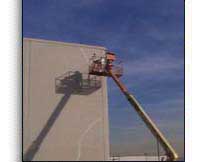Paint Problems and Solutions
Blistering
Blistering Probable Causes:
Trapped moisture trying to escape through the paint, painting at
temperatures above 90 F. Using oil paints on wet/damp surfaces. High humidity, such as rain
or heavy dew before the paint dries. Painting a warm surface in direct sunlight.
Blistering Solution:
Find and remove the sources of moisture. Control moisture with adequate venting,
stopping leaks and acrylic caulking. Remove all of the blistered areas and other loose paint by
scraping and sanding. Power washing recommended for large areas.
Primers & Exterior Finishes:
Priming is essential for better adhesion, sheen uniformity, mildew control and durability.
Select a top quality exterior paint in the color and sheen of your choice.
 top
top
Checking / Flaking
This is aging, dried paint that starts with hairline cracks. Eventually cracking to the surface.
Checking Probable Causes:
Poor surface prep. Applying paint too thin. Loss of elasticity,
not expanding or contraction with humidity and temperature. As wood swells, stress breaks
the bond between layers. Checking on unprotected wood is due to delaminating.
Checking Solutions:
Remove all loose paint with a scraper, wire brush or power washing for large areas. Feather sand edges.
Level uneven areas with exterior spackle, sand and rinse with a garden hose to remove all dust particles.
Primers & Exterior Finishes:
Priming is essential for better adhesion, sheen uniformity, mildew control and durability.
Select a top quality exterior paint in the color and sheen of your choice.
 top
top
Dirt Staining
This is the excessive collection of dirt and other debris. Sometimes mistaken for mildew.
Dirt Staining Probable Causes:
Usually a combination of air pollution and flying dust. Coarse flat finishes are particularly
vulnerable to dirt penetration and staining. The like and beauty of exterior paints may be
extended by properly washing as needed.
Dirt Staining Solutions
Wash off all loose dirt and other particles before repainting. Use a scrub brush and a detergent
solution with household bleach (1 part bleach / 3 parts water) to also kill mildew if present.
Power washing recommended for speed. Rinse to remove all loose particles.
Primers & Exterior Finishes:
Priming is essential for better adhesion, sheen uniformity, mildew control and durability.
Select a top quality exterior paint in the color and sheen of your choice.
 top
top
Lapping
Lapping occurs where wet and dry layers overlap during painting. Avoid with paint area
management and technique.
Lapping Probable Causes:
Wet and dry layers overlapping. Too much heat or wind during application. Inadequate stirring
and improper thinning. Extremely porous surface, painting too large an area at a time, such
as trying to go from the top to the bottom.
Lapping Solutions:
Another coat of paint evenly spread usually will cover lap marks. If the finish coat is
relatively transparent or if the surface is overly porous, a primer or second coat may
be necessary. Always paint from wet to dry and in small sections to keep a wet edge.
Primers & Exterior Finishes:
Priming is essential for better adhesion, sheen uniformity, mildew control and durability.
Select a top quality exterior paint in the color and sheen of your choice.
 top
top
Mildew
Mildew … areas of black, gray, brown spots formed on paints and other surfaces, particularly
in damp, shady areas.
Mildew Probable Causes:
Warm humid conditions, poor air circulation and little direct sunlight, like under eaves
and overhangs. Shrubbery planted too close to a building is an ideal place for mildew to
grow. Mildew must be removed before painting or it will come through the new paint.
Mildew Solutions:
Remove all mildew by scrubbing with a solution of household bleach and water. Mix one
part bleach to three parts water. Wear rubber gloves and eye protection. Power washing
is recommended for larger areas. Rinse thoroughly with garden hose.
Primers & Exterior Finishes:
Priming is essential for better adhesion, sheen uniformity, mildew control and durability.
Select a top quality exterior paint in the color and sheen of your choice.
 top
top
Nailhead Rusting
Nailhead Rusting … rust spots come through the paint. Preventable with proper surface preparation and priming.
Rust Stains Probable Causes:
Improper surface preparation. Use of nails not protected against rusting. Failure to countersink,
acrylic caulk and apply rust inhibitive primer. Painting over rusty nailheads, in a short time
the rust will bleed through again.
Nailhead Rusting Solutions:
Countersink the nails, use acrylic caulk and spot prime. Rust spots will reappear if you repaint
over the rusty spots caused by nails or other rusting metals without described preventative
measures. Specify galvanized aluminum or stainless steel nails.
Primers & Exterior Finishes:
Priming is essential for better adhesion, sheen uniformity, mildew control and durability.
Select a top quality exterior paint in the color and sheen of your choice.
 top
top
Wrinkling
Caused by improper paint application (usually too thick) can cause paint to have a crinkled surface.
Wrinkling Probable Causes:
Usually occurs when there is interference with normal drying, such as: applying too much paint, applying second coat too soon, uncured paint exposure to excessive moisture conditions, painting when it is too hot or cold and painting over un-sanded glossy surface.
Wrinking Solutions:
Remove wrinkled areas and other loose paint. Aged wrinkled areas may require chemical paint removers. Wear safety gear as directed. Sand until smooth. Remove dust. Apply at recommended spread rates. Avoid extreme temperatures: Below 50 F. and above 100 F.
Primers & Exterior Finishes:
Priming is essential for better adhesion, sheen uniformity, mildew control and durability. Select a top quality exterior paint in the color and sheen of your choice.
 top
top
The above tips are compliments of Spectra-Tone Paint.


